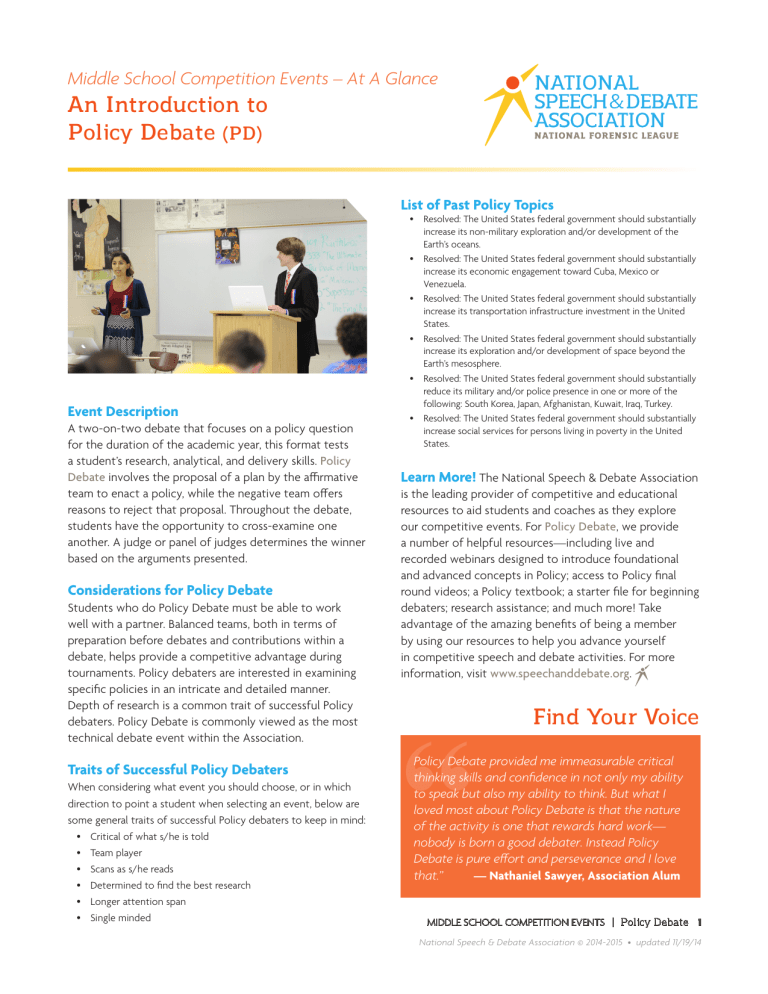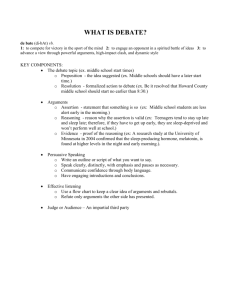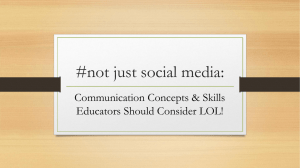
Middle School Competition Events – At A Glance An Introduction to Policy Debate (PD) List of Past Policy Topics • • • • • Event Description A two-on-two debate that focuses on a policy question for the duration of the academic year, this format tests a student’s research, analytical, and delivery skills. Policy Debate involves the proposal of a plan by the affirmative team to enact a policy, while the negative team offers reasons to reject that proposal. Throughout the debate, students have the opportunity to cross-examine one another. A judge or panel of judges determines the winner based on the arguments presented. Considerations for Policy Debate Students who do Policy Debate must be able to work well with a partner. Balanced teams, both in terms of preparation before debates and contributions within a debate, helps provide a competitive advantage during tournaments. Policy debaters are interested in examining specific policies in an intricate and detailed manner. Depth of research is a common trait of successful Policy debaters. Policy Debate is commonly viewed as the most technical debate event within the Association. Traits of Successful Policy Debaters When considering what event you should choose, or in which direction to point a student when selecting an event, below are some general traits of successful Policy debaters to keep in mind: • Critical of what s/he is told • Team player • Scans as s/he reads • Determined to find the best research • Resolved: The United States federal government should substantially increase its non-military exploration and/or development of the Earth’s oceans. Resolved: The United States federal government should substantially increase its economic engagement toward Cuba, Mexico or Venezuela. Resolved: The United States federal government should substantially increase its transportation infrastructure investment in the United States. Resolved: The United States federal government should substantially increase its exploration and/or development of space beyond the Earth’s mesosphere. Resolved: The United States federal government should substantially reduce its military and/or police presence in one or more of the following: South Korea, Japan, Afghanistan, Kuwait, Iraq, Turkey. Resolved: The United States federal government should substantially increase social services for persons living in poverty in the United States. Learn More! The National Speech & Debate Association is the leading provider of competitive and educational resources to aid students and coaches as they explore our competitive events. For Policy Debate, we provide a number of helpful resources—including live and recorded webinars designed to introduce foundational and advanced concepts in Policy; access to Policy final round videos; a Policy textbook; a starter file for beginning debaters; research assistance; and much more! Take advantage of the amazing benefits of being a member by using our resources to help you advance yourself in competitive speech and debate activities. For more information, visit www.speechanddebate.org. “ Find Your Voice Policy Debate provided me immeasurable critical thinking skills and confidence in not only my ability to speak but also my ability to think. But what I loved most about Policy Debate is that the nature of the activity is one that rewards hard work— nobody is born a good debater. Instead Policy Debate is pure effort and perseverance and I love that.” ­— Nathaniel Sawyer, Association Alum • Longer attention span • Single minded MIDDLE SCHOOL COMPETITION EVENTS | Policy Debate 1 National Speech & Debate Association © 2014-2015 • updated 11/19/14 Middle School Competition Events Guide Policy Debate (PD) Basic Understandings Research Policy debate is a two-on-two debate where an affirmative team proposes a plan and the negative team argues why that plan should not be adopted. The topic for policy debate changes annually, so debaters throughout the course of the year will debate the same topic. Policy debate is a very research-intensive activity. Unlike traditional writing where the author may briefly quote or even paraphrase evidence, Policy Debate relies on the use of cards, or pieces of evidence directly quoted word-forword from the source. The debate unfolds throughout a series of speeches as outlined below: A typical piece of evidence consists of three parts: the tagline, the citation, and the evidence. The tagline is the argument or claim that either the evidence asserts or that the debater is asserting based on the evidence. For example, if the Department of Labor had produced a report saying that more people have left the workforce, the tagline might be ‘The number of discouraged workers are on the rise’ or ‘The federal government must respond to the growing number of people leaving the workforce.’ The citation provides the information necessary to track down the source, similar to an MLA/APA citation. The author, the title, the publication the source, the page, etc. This information will not be read aloud in the round except for the author and the year (or more specific date if necessary). Finally, a piece of evidence consists of the text of the evidence itself. The expectation in Policy Debate is that cards are read verbatim, so the paraphrasing of evidence as it is being read for the first time is discouraged. Instead, the debater should underline or bold the parts of the text of the evidence they deem most necessary. Please see the resources provided by the Association (listed at the end of this guide) for examples of evidence and cut cards. 1st Affirmative Constructive 1AC 8 minutes Negative Cross-Examination of Affirmative 3 minutes 1st Negative Constructive 1NC 8 minutes Affirmative Cross-Examination of Negative 3 minutes 2nd Affirmative Constructive 2AC 8 minutes Negative Cross-Examination of Affirmative 3 minutes 2nd Negative Constructive 2NC 8 minutes Affirmative Cross-Examination of Negative 3 minutes 1st Negative Rebuttal 1NR 5 minutes 1st Affirmative Rebuttal 1AR 5 minutes 2nd Negative Rebuttal 2NR 5 minutes 2nd Affirmative Rebuttal 2AR 5 minutes Prep Time (each team) 8 minutes One member of each team will perform the ‘first’ speeches, the other the ‘second’ speeches. So the person who reads the 1AC wil also perform the 1AR, for example. Note that the debate begins with the affirmative speaking first, and then switches midway through the debate where the negative speaks first, thus giving the affirmative the ability to speak last. So where do all these cards come from? The Association offers a starter pack of affirmative and negative evidence, as well as biweekly updates of evidence research for resource package members. There are other resources available, one of which is the National Debate Coaches Open Evidence Project. As debaters become more advanced, they are better served, though, if they use evidence they have compiled from original research. Scholarly databases, news outlets, books, journal articles, and other reputable sources are great avenues for finding the best evidence. As research is gathered, be sure to organize your findings based on argument and when you may use that evidence in a round. MIDDLE SCHOOL COMPETITION EVENTS | Policy Debate 2 National Speech & Debate Association © 2014-2015 • updated 11/19/14 Middle School Competition Events Guide Policy Debate (PD) Structural Components Affirmative The affirmative begins the debate by offering a plan, a specific example of the year’s topic or resolution, and arguing that it is a good idea. In many circumstances, they will address the “stock issues” of a case in Policy Debate; in other instances, they may use a more advanced format of simply discussing advantages to the plan. The ultimate goal of the affirmative is to advocate for the passage of a plan that falls under the resolution. The presumption is that the status quo, or the way things are in the world without the passage of the plan, is worth rejecting in favor of living in a world with the plan adopted. Thankfully for the affirmative, they do not have to demonstrate that the plan would pass in the real world, only that it should. Policy proposals that may never survive the political climate of Congress are still fair game under the presumption of fiat—or the ability of the affirmative to will their plan into existence without having to worry about whether or not it would actually be adopted. To convince audiences to adopt their plan, affirmative cases directly or indirectly address the stock issues of significance, harms, inherency, topicality, and solvency. The Policy 101 debate textbook covers these issues in greater detail. Negative The negative has a wide variety of strategies available to respond to the affirmative case. The presumption in policy debate is that if the negative can win one of the aforementioned stock issues, they win the debate. Alternatively, the negative can demonstrate that the harms of the plan outweigh the benefits. These strategies are divided into two broad types: on-case and off-case. On-case responses to the affirmative position clash directly with arguments posed by the plan’s advocates and generally focus on the stock issues. If the affirmative says the plan will save 500,000 lives, the negative may attempt to demonstrate why that claim is untrue. If the affirmative says we are wasting billions of dollars in the status quo on inefficient research, the negative may demonstrate why that research is necessary. We will discuss the structure of those arguments in a moment. Off-case responses are positions developed that do not directly respond to the arguments posed by the affirmative. This can consist of a variety of positions. First, the negative may offer a disadvantage, or a harm or problem that will be caused when the plan is passed. Disadvantages must generally prove that a harm is brewing in the status quo, something about the passage of this plan will bring that harm into reality or intensify it, and then discuss the impacts of those harms. Second, the negative may propose a counter-plan, or a competitive, non-topical, mutually exclusive plan proposal compared to the affirmative. Third, the negative may directly address the topicality of the affirmative position, arguing that the affirmative’s plan is not an example of the resolution, by providing definitions for the words of the resolution, showing how the affirmative fails to meet those definitions, and then discussing why the affirmative case ought to lose for violating this debate rule. Organizing Keeping track of the arguments during the debate can be challenging, but most debaters flow arguments separately. The different components of the affirmative case (significance, harms, inherency, etc.) can be flowed on one sheet of paper or each position may be tracked separately. The negative will typically keep track of arguments on separate pieces of paper (the first disadvantage on one, the topicality on a second, a counterplan on the third, etc.). Arguments are listed shorthand on one side of the page. Each response is flowed in a different color ink MIDDLE SCHOOL COMPETITION EVENTS | Policy Debate 3 National Speech & Debate Association © 2014-2015 • updated 11/19/14 Middle School Competition Events Guide Policy Debate (PD) next to it representing the two sides of the debate— affirmative arguments may be listed in black while negative arguments are listed in red, for example. More details on how to flow and different flowing techniques can be found in the resource section below. Standing it Up/Practicing Policy debate can be a fast-talking event! With strict time limits and the need to present arguments supported by well-articulated research, students will speak as efficiently as possible. Your first foray into performance practice should be reading your case and your positions out loud with a stop-watch. See how long it takes for you to read your case (and make sure your affirmative constructive is in time!). Focus on enunciation and pronunciation as you go. Remember, fewer and better-explained arguments will often win more debates. Ultimately, your judgesset the pace for the round and so you should be prepared to speak at the speed they prefer. answering? Now’s a great time to talk to your coach or teammates on how to prepare a “block” to use in future debates. Is there a card you wish you had in the round? Now’s a good time to find it! Do you seem to have trouble finding the material you have gathered when you need it? Take a look at the organization of your files. Following the tournament, you can use your old flows to discuss strategy—what arguments seemed to work? What could you have improved on? Some tournaments feature elimination rounds following the guaranteed preliminary rounds. If you advance and get to debate again, congratulations! It’s just like any other round, except typically you will have a panel of judges as opposed to just one. If you don’t, use this as an opportunity to observe other rounds to learn more about how to debate effectively. It is always helpful to have practice debates before your first contest, against either teammates or even teams from other schools. These debates should be instructional in nature—the goal isn’t to ‘win.’ Performance Tips The first tournament can be an intimidating experience, but don’t worry! Every round is an opportunity to learn! Approach your first rounds with confidence and act like you’ve done this before, even if you haven’t. Prior to the debate, you may ask your judge if they have any preferences or paradigms, which will clue you into what kinds of arguments they may prefer and which kinds they may not. When your first round is over, keep your flows and listen to the advice the judge has to offer, either during the oral critique or written down on the ballot. Consult with your coach after the round to see how best to implement feedback. Keep these notes for future tournaments—it is not unusual to have the same judge several times during a year! Between rounds, it is not unusual for debaters to gather more evidence and look at the organization of their files. Was there an argument you had trouble explaining or Resources The resource page provided by the National Speech and Debate Association provides a variety of resources to help you in debate! The Debate 101 textbook will further your understanding of the fundamentals of the event and provide tips and tricks for developing arguments. The Introduction to Policy Debate section includes several helpful videos including how to decide a policy debate, tips for flowing, further understanding stock issues, and other topics. You can also find videos of previous final rounds to see Policy Debate in action! Our general resources for Resource Package subscribers include evidence updates, starter packets, and other research resources to help get your files started. MIDDLE SCHOOL COMPETITION EVENTS | Policy Debate 4 National Speech & Debate Association © 2014-2015 • updated 11/19/14




